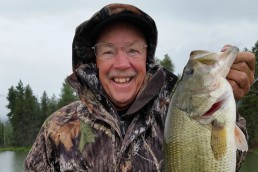Go Shallow…Go Deep
SHARE THIS POST
No matter what species of fish you’re looking to catch this summer, Jim Kalkofen says you need to look for any forms of grass, submergent or emergent.
Way back in the days prior to electronics, we kids fished all summer. Hot days; rainy, blustery days—in northern Wisconsin, those days we fished anywhere we could fish. Shallow was where most of our nightcrawlers and fathead minnows landed. Whatever we dangled below bobbers, it was shallow. Living in the same town where Mepps spinners were made meant we had to cast these fish-catching wonders, also.
We fished in the weeds. We fished in pockets in the weeds. We worked the edges.
This time of year, bass, panfish and walleyes are lurking in and around weed beds. The deeper the weeds, the better. There are weeds in Pelican Lake in the Brainerd, Minn. area that grow in 30-plus feet of water. Rigging a chub around these key spots attracts walleyes.
The deepest edges of weeds in dark-water lakes might be 6 to 10 feet deep; in less stained water, down to 15 (or so) feet. In ultra-clear lakes, weeds grow to 20-plus feet. The outside edges are fish magnets for all species from bass to pike to muskies to walleyes. The biggest bluegills in the lake often prefer these areas, and the same tactic from 50 years ago—a nose-hooked nightcrawler on a number 8 Aberdeen hook with a split shot crimped onto the line about 2 feet above the hook—produces big ‘gills. Expect to also land walleyes and bass on this simple rig.
Examining one typical fishy spot—weeds—takes a fisherman from shallow down deep in a hurry. Replace the ‘crawler with a leech and experience the same results.
Are you enjoying this post?
You can be among the first to get the latest info on where to go, what to use and how to use it!
Casting or trolling deep cranks parallel to weed edges catches fish. If trolling, use tattle flags on your Off-Shore boards to tell if/when weeds foul the lure. Run bottom bouncers with spinners in the same areas. With bait-stealing perch, use PowerBait, Acme, Northland or Custom Jigs and Spins plastic worms and leeches. Pick your favorite color. Usually, these worms only need to be 3 or 4 inches long. The spinner rig should have large-gap hooks to accommodate the plastic and still connect when a fish bites.
My favorite weeds are popularly called green cabbage weeds. Some of the biggest bluegills and crappies seem to love these weeds. Flipping 1/16-ounce jigs with 2-inch Twister tails and letting them drop, sweeping the rod up, retrieving a bit of line and repeating works wonders.
Bass chasers know the allure of green cabbage. They ply these areas with spinnerbaits, topwater lures, jerk baits and weedless jigs. From inside to the edges, cabbage weeds and bass go together. Pike and muskies lurk here, also. Walleyes have another name for cabbage weeds. They call this place home. Walleyes will stay nearby from summer to late fall. Don’t give up on areas that produce in July and August. Fish will still be here to ice-up as long as some green weeds remain.
Some fishermen stay away from weeds because they don’t like to get snagged. That is the price to pay for catching fish. Fishing in and around weeds was how I started and is also where I enjoy fishing today.
For more knowledge on fishing techniques you may not have tried before, check out the summer issue of MidWest Outdoors, available now at the newsstand or by subscribing on our website.
MWO
SHARE THIS POST
You may also like...
Nothing found.
Did you enjoy this post?
You can be among the first to get the latest info on where to go, what to use and how to use it!
Jim Kalkofen
Jim Kalkofen grew up with a fishing rod in his hands. After years in the PR game for Mercury and Mepps, he directed the Professional Walleye Trail. He and partners Al and Ron Lindner now provide weekly walleye and ice-fishing education and entertainment in Target Walleye/Ice, a free subscription email (targetwalleye.com). For more info: jim@targetwalleye.com or 651-356-5676.
